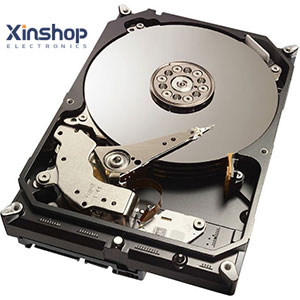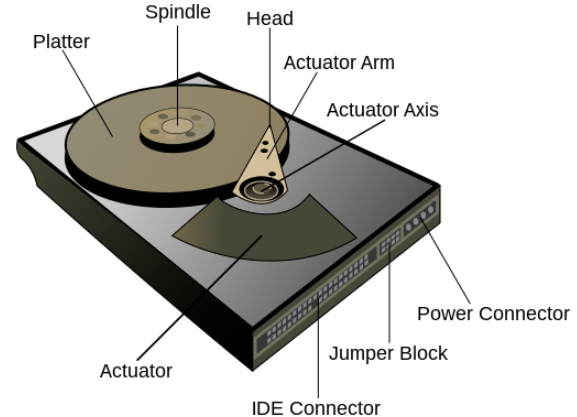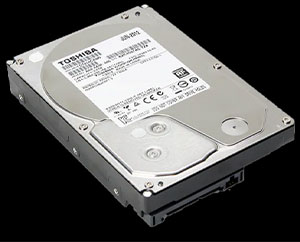
How do Hard Disk Drives Work? Operation, Types Explain
yunying Release time:2024-02-27 Page View:402

This post tells you what is Hard Disk Drives and how it Works...And other frequent asked questions you want to know
What are Hard Disk Drives?
Hard Disk Drives (HDDs) are a type of non-volatile storage device used in computers and other electronic devices to store and retrieve digital data. Here is an overview of how HDDs work, their
operation, types, and some key details:
What are the main parts of a hard disk?

History
The history of Hard Disk Drives (HDDs) dates back to the mid-20th century. Here is a brief overview of the key milestones in the history of HDDs:
1. **1950s**: The concept of magnetic storage for computers was developed in the 1950s, leading to the creation of the first magnetic drum memory units.
2. **1956**: IBM introduced the first commercial Hard Disk Drive, the IBM 305 RAMAC (Random Access Method of Accounting and Control). It had a storage capacity of 5MB and consisted of 50 24-inch diameter disks.
3. **1960s-1970s**: HDDs continued to evolve with improvements in storage capacity, speed, and reliability. The introduction of smaller form factors and advances in technology allowed for increased storage densities.
4. **1980s**: The introduction of Winchester technology by IBM in the 1980s revolutionized HDD design. Winchester drives featured sealed assemblies with read/write heads that floated on a thin film of air, providing higher storage capacities and reliability.
5. **1990s**: The 1990s saw a significant increase in HDD capacities, with drives reaching several gigabytes. This era also saw the transition from IDE (Integrated Drive Electronics) to SATA (Serial ATA) interfaces.
6. **2000s**: The 2000s marked the rise of portable HDDs and the introduction of faster spinning speeds, higher data transfer rates, and larger cache sizes. The development of perpendicular magnetic recording (PMR) technology allowed for even higher storage densities.
7. **2010s-Present**: The past decade has seen the proliferation of Solid State Drives (SSDs) as a faster and more durable alternative to traditional HDDs. SSDs have gained popularity in consumer electronics and data centers, offering improved performance and reliability.
Throughout its history, HDD technology has continuously evolved to meet the growing demands for storage capacity, speed, and reliability in various computing applications. Despite the rise of SSDs, HDDs continue to be used in many devices and systems where cost-effective, high-capacity storage is required.
Operation
1. **Platters**: HDDs consist of one or more spinning disks called platters coated with a magnetic material. Data is stored on these platters in binary form
using magnetization.
2. **Read/Write Heads**: Each platter has a read/write head that moves across its surface to read or write data. The heads are positioned on an actuator arm,
which moves them rapidly over the surface of the platters.
3. **Magnetic Recording**: Data is stored on the platters in concentric circles called tracks. Each track is divided into smaller sectors where data is actually
written. When data is written, the magnetic orientation of tiny regions on the platter is changed.
4. **Spindle**: The platters are mounted on a spindle that rotates them at high speeds, typically ranging from 5,400 to 15,000 revolutions per minute (RPM).
5. **Controller**: An onboard controller manages data access, communication with the computer, error correction, and other functions necessary for the
drive to operate efficiently.
Working Principle
- When a computer needs to read or write data, the read/write heads move to the appropriate location on the platter.
- Data is transferred to or from the drive via electrical signals sent through the drive's interface (e.g., SATA, SAS).
- The spinning platters and moving heads create a mechanical system vulnerable to damage from physical shocks, making HDDs more prone to failure than solid-state drives (SSDs).
Types of HDDs

1. **Desktop HDDs**: These are larger 3.5-inch drives commonly used in desktop computers and external storage solutions. They offer higher capacities and are often faster than smaller drives.
2. **Laptop HDDs**: Also known as 2.5-inch drives, these are smaller and more power-efficient drives used in laptops and portable devices. They typically have lower capacities but are more compact.
3. **Enterprise HDDs**: Designed for server and data center use, these drives offer high capacities, reliability, and performance to meet the demanding
requirements of enterprise environments.
4. **Solid-State Hybrid Drives (SSHDs)**: These drives combine traditional HDD storage with a small amount of solid-state storage for improved performance. Frequently accessed data is stored on the solid-state portion for faster access.
Related questions you may want to know:
Are floppy disks faster than accessing hard drives?
**Floppy Disks vs. Hard Drives**: In terms of access speed, hard drives are generally faster than floppy disks. Floppy disks have a slower data transfer rate and smaller storage capacity compared to hard drives. Hard drives use faster spinning disks and more advanced technology for data storage and retrieval, making them quicker than floppy disks.
What is the surface of a hard drive platter made of?
**Surface of a Hard Drive Platter**: The surface of a hard drive platter is typically made of a thin layer of magnetic material. This material allows data to be written and read using the magnetic heads that move across the spinning platters. The magnetic material on the platter retains the digital information in the form of magnetic fields.
Why is a disk degragmenter necessary in hard drives?
**Disk Defragmenter**: Over time, as files are written, deleted, and modified on a hard drive, they can become fragmented, meaning parts of a single file may be stored in different physical locations on the disk. This fragmentation can slow down the access speed of the hard drive because the drive has to search different locations to retrieve a single file. A disk defragmenter reorganizes the data on the hard drive, placing related data blocks closer together for faster access speeds.
Why is a hard disk fast to access?
**Speed of Access on a Hard Disk**: A hard disk is fast to access data for several reasons:
- **Rotational Speed**: Hard drives have spinning platters that rotate at high speeds. The faster the platters spin, the quicker the read/write heads can access data.
- **Data Density**: Hard drives store data densely on the platters, allowing for more data to be read or written in a single rotation.
- **Caching**: Hard drives often use cache memory to store frequently accessed data, reducing the time needed to retrieve that data from the disk.
- **Seek Time**: Seek time refers to the time it takes for the read/write heads to move to the correct location on the disk. Lower seek times result in faster data access.
- **Interface Speed**: The interface between the hard drive and the computer (e.g., SATA, NVMe) plays a role in determining how fast data can be transferred to and from the drive.
Overall, a combination of these factors makes a hard disk fast to access data compared to slower storage mediums like floppy disks.
Do SSDs last longer than HDDs? Why or why not?
Do solid state drives run hotter than regular hard drives?
Why is SSD not a good option for long-term storage?
Will hard-disk drives be replaced by Solid-State drives?
In conclusion, HDDs store and retrieve data magnetically on spinning platters using read/write heads. They come in various types tailored for different
applications, offering a balance between capacity, performance, and cost compared to other storage technologies like SSDs

Frequently Asked Questions
What is Magnetic Disk Drives
Magnetic Disk Drives: This term is often used interchangeably with HDDs, as both refer to storage devices that use magnetic disks to store data. The disks in these drives are coated with a magnetic material that can be magnetized to represent digital data.
Does a hard disk drive get measurably slower with age?
Over time, a hard disk drive (HDD) can experience degradation in performance due to various factors such as mechanical wear and tear, fragmentation of data, and potential errors on the disk surface. As a hard drive ages, these factors can contribute to a decrease in performance, resulting in slower read and write speeds. Additionally, as the drive fills up with data, it may also impact performance due to increased seek times. However, the rate of performance degradation can vary depending on the usage patterns, quality of the drive, and environmental conditions.
What happens if a hard drive platter scratches?
If a hard drive platter gets scratched, it can lead to data loss and potentially cause the drive to malfunction. A scratch on the platter can damage the magnetic surface where data is stored, making it unreadable or corrupting the data in that area. In severe cases, a deep scratch can render the affected portion of the disk unusable and may require professional data recovery services to retrieve any salvageable data.
What happens when you drop your hard drive?
Dropping a hard drive can cause physical damage to the delicate internal components, including the read/write head, platters, and spindle motor. This can lead to misalignment of the read/write head, scratches on the platters, or other mechanical issues that can result in data loss or drive failure. It is crucial to handle hard drives with care and avoid subjecting them to physical shocks or impacts to prevent damage.
Why are hard drives air sealed?
Hard drives are air sealed to create a controlled environment inside the drive that is free from contaminants such as dust, moisture, and other particles that can potentially damage the internal components. The air-sealed enclosure maintains a stable internal pressure and helps to prevent oxidation of the platters' magnetic surface, ensuring the longevity and reliability of the drive. Additionally, the air seal helps to maintain the proper operating conditions for the sensitive components within the drive, such as the read/write head and platters, to ensure optimal performance and data integrity.
-
1,000+Daily Order Quantity
-
2,500,000+Alternative Parts
-
2,200+Worldwide Manufacturers
-
10,000 ㎡In-stock Warehouse


























